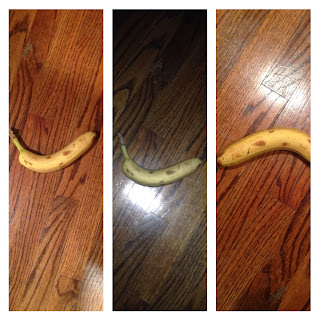Shape constancy which is also known as form constancy is a form of perceptual constancy where a familiar object keeps its perceived shape despite major changes in retinal stimulation due to changes in its orientation. The photo below shows two different views of an orange yet we can see that it is the exact same size.
Wednesday, November 6, 2013
Brightness Constancy
Brightness constancy is when we observe that an object emits the same amount of light even when the light around the object differs. The photo shows three different photos of a banana under different lighting conditions but we can tell that the banana is still the same exact brightness.
Size Constancy
Size constancy is an aspect of perceptual constancy in which an object will appear to be the same size to an observer despite of changes in light , rotation, distance, perspective. The photo below is an example of size constancy because no matter what angle the photo is taken the glove still looks the same exact size.
Monocular Cue # 2
This is the second example of a monocular cue. We can tell that the lights are getting farther and farther away because they begin to narrow this is another great example of a monocular cue.
Monocular Cue #1 and Definition
Monocular cues provide depth information when viewing a scene with one eye. An example of this would be the picture shown below. We can tell that the one shoe is farther away than the other because the one to the right looks smaller than the other and our mind sees that as it being farther away, which it is.
Tuesday, November 5, 2013
Motion Perception
Motion perception is the process of inferring speed and direction of elements in a scene based on visual, vestibular and proprioceptive inputs. An example of this would be the picture seen below.
Binocular Cue
Figure-ground perception
The figure ground perception is a type of grouping that is needed for seeing objects through vision it is known as identifying a figure from the background. An example would be the two faces seen arguing in the Canadian flag.
Proximity
The proximity principle accounts for the tendency for individuals to form interpersonal relations with those close by. An example would be with roommates in college who previously did not know each other. Because they are forced to live together they usually become friends from sharing such a small space.
Similarity
The similarity perception states that items that are similar tend to be grouped together. An example would be this photo shown below.
Continuity
The continuity perception states that people have a tendency to group stimuli to continuous lines and patterns. An example would be this photo below. In the photo there are many different objects placed together, however most people view this as a gun because of the continuous lines that can be made out in the photo.
Closure
Closure perception is when we see objects grouped together as a whole. The photo shown below is an example of this. The wheelchair symbol is not closed yet we see it as a whole.
Subscribe to:
Comments (Atom)
.JPG)

.JPG)
.JPG)
.JPG)

.JPG)


